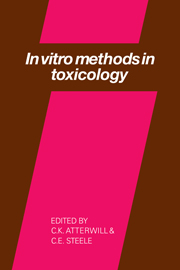Book contents
- Frontmatter
- Contents
- List of contributors
- Preface
- Introduction
- TARGET ORGAN TOXICITY
- In vitro methods in renal toxicology
- Ototoxicity
- Cultured cell models for studying problems in cardiac toxicology
- Use of the isolated rat heart for the detection of cardiotoxic agents
- Brain reaggregate cultures in neurotoxicological investigations
- Application of thryoid cell culture to the study of thyrotoxicity
- In vitro methods to investigate toxic lung disease
- Metabolism and toxicity of drugs in mammalian hepatocyte culture
- In vitro evaluation of haemic systems in toxicology
- GENERAL AND TOPICAL TOXICITY
- REPRODUCTIVE TOXICITY
- CONCLUSION
- Index
Ototoxicity
Published online by Cambridge University Press: 06 August 2010
- Frontmatter
- Contents
- List of contributors
- Preface
- Introduction
- TARGET ORGAN TOXICITY
- In vitro methods in renal toxicology
- Ototoxicity
- Cultured cell models for studying problems in cardiac toxicology
- Use of the isolated rat heart for the detection of cardiotoxic agents
- Brain reaggregate cultures in neurotoxicological investigations
- Application of thryoid cell culture to the study of thyrotoxicity
- In vitro methods to investigate toxic lung disease
- Metabolism and toxicity of drugs in mammalian hepatocyte culture
- In vitro evaluation of haemic systems in toxicology
- GENERAL AND TOPICAL TOXICITY
- REPRODUCTIVE TOXICITY
- CONCLUSION
- Index
Summary
INTRODUCTION
Drugs or chemicals which can damage the inner ear are termed ototoxic. The inner ear, surrounded by the temporal bone, comprises the cochlea, or organ of hearing, and the vestibular structures, the organs of balance (Figure 1). The various cavities of the inner ear are divided by membranous partitions, creating several compartments which are filled with one of two fluids: perilymph, resembling other extracellular fluids in composition, or endolymph, the only extracellular fluid in the body with an electrolyte content similar to intracellular fluid, i.e. with a high potassium, low sodium concentration. The elements of the vestibular system are the three cristae ampullares within the semi-circular canals and the two maculae of the utricle and the saccule. In each of these five structures are located the sensory cells, the vestibular hair cells (HCs), so called because a tuft of stereocilia projects from the surface of each cell. The cells are responsive to movements of the head and send information to the vestibular nuclei in the brainstem via the vestibular primary afferent neurones with which they synapse. The cochlea is not a simple curved structure as depicted in Figure 1 but rather has a helical form making several turns from base to apex (the actual number of turns varies between species) around a central bony spindle which contains the nerve supply to the sensory structures.
- Type
- Chapter
- Information
- In Vitro Methods in Toxicology , pp. 37 - 58Publisher: Cambridge University PressPrint publication year: 1987
- 2
- Cited by



